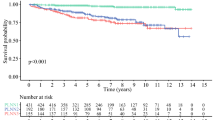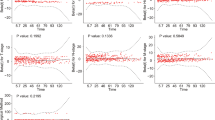Abstract
Background
Nomogram could estimate individualized prognosis in papillary thyroid carcinoma (PTC). We aimed to create and validate a new nomogram and compare it with other published nomograms using a large patient cohort.
Methods
Eight-hundred and forty-nine PTC patients with ≥7 years follow-up were randomly assigned to the development (n = 425) and validation (n = 424) groups. The former was used for developing a nomogram for disease-specific survival (DSS), while the latter was for validating the nomogram by discrimination [or area under curve (AUC)]. AUC of the newly developed nomogram was compared to other published nomograms.
Results
The 5- and 10-year risk of dying from PTC were 1.4 and 3.3 %, respectively, while dying from non-PTC-related causes were 2.3 and 5.1 %, respectively. The new nomogram was developed from age, tumor size, multifocality, nodal status and distant metastases. The discrimination was excellent (AUC (95 % CI) for 5- and 10-year DSS were 0.896 (0.683–0.971) and 0.919 (0.871–0.967), respectively). Its predictability was similar to other published nomograms (p > 0.05). Based on the new nomogram, a total score of <28 meant 99.72 % chance of surviving from PTC at 10 years while a score of ≥28 meant 9.09 % chance of dying from PTC at 10 years.
Conclusions
Using variables from the current tumor node metastasis (TNM) staging system, a new nomogram was developed. It exhibited excellent discriminatory ability and accuracy in predicting 10-year DSS relative to other published nomograms. However, given the excellent prognosis of PTC, the new nomogram was better at ruling out than predicting PTC-related death. Further validation by an external cohort is required.


Similar content being viewed by others
References
Cancer incidence and mortality in Hong Kong 1983–2012. Hong Kong Cancer Registry, Hong Kong. Available: http://www3.ha.org.hk/cancereg/e_stat.asp. Accessed 9 Dec 2014
Morris LG, Sikora AG, Tosteson TD, Davies L (2013) The increasing incidence of thyroid cancer: the influence of access to care. Thyroid 23(7):885–891
Lang BH, Chow SM, Lo CY, Law SC, Lam KY (2007) Staging systems for papillary thyroid carcinoma: a study of 2 tertiary referral centers. Ann Surg 246(1):114–121
Lang BH, Lo CY, Chan WF, Lam KY, Wan KY (2007) Staging systems for follicular thyroid carcinoma: application to 171 consecutive patients treated in a tertiary referral centre. Endocr Relat Cancer 14(1):29–42 Review
Kattan MW, Scardino PT (2007) Evidence for the usefulness of nomograms. Nat Clin Pract Urol 4(12):638–639
Touijer K, Scardino PT (2009) Nomograms for staging, prognosis, and predicting treatment outcomes. Cancer 115(13 Suppl):3107–3111. doi:10.1002/cncr.24352
Pathak KA, Mazurat A, Lambert P, Klonisch T, Nason RW (2013) Prognostic nomograms to predict oncological outcome of thyroid cancers. J Clin Endocrinol Metab 98(12):4768–4775
Yang L, Shen W, Sakamoto N (2013) Population-based study evaluating and predicting the probability of death resulting from thyroid cancer and other causes among patients with thyroid cancer. J Clin Oncol 31(4):468–474
Ho AS, Wang L, Palmer FL et al (2014) Postoperative nomogram for predicting cancer-specific mortality in medullary thyroid cancer. Ann Surg Oncol. doi:10.1245/s10434-014-4208-2
Wang TS, Sosa JA (2013) Thyroid gland: can a nomogram predict death in patients with thyroid cancer? Nat Rev Endocrinol 9(4):192–193
Lang BH, Lo CY, Wong KP, Wan KY (2014) Long-term outcomes for older patients with papillary thyroid carcinoma: should another age cutoff beyond 45 years be added? Ann Surg Oncol. doi:10.1245/s10434-014-4055-1
Fine JP, Gray RJ (1999) A proportional hazards model for the subdistribution of a competing risk. J Am Stat Assoc 94:496–509
DeLong ER, DeLong DM, Clarke-Pearson DL (1988) Comparing the areas under two or more correlated receiver operating characteristic curves: a nonparametric approach. Biometrics 44(3):837–845
Grogan RH, Kaplan SP, Cao H, Weiss RE, Degroot LJ, Simon CA, Embia OM, Angelos P, Kaplan EL, Schechter RB (2013) A study of recurrence and death from papillary thyroid cancer with 27 years of median follow-up. Surgery 154(6):1436–1446 discussion 1446–1447
Kim KJ, Kim SM, Lee YS, Chung WY, Chang HS, Park CS (2014) Prognostic significance of tumor multifocality in papillary thyroid carcinoma and its relationship with primary tumor size: a retrospective study of 2309 consecutive patients. Ann Surg Oncol. doi:10.1245/s10434-014-3899-8
Qu H, Sun GR, Liu Y, He QS (2014) Clinical risk factors for central lymph node metastasis in papillary thyroid carcinoma: a systematic review and meta-analysis. Clin Endocrinol (Oxf). doi:10.1111/cen.12583
Vaisman F, Momesso D, Bulzico DA, Pessoa CH, Dias F, Corbo R, Vaisman M, Tuttle RM (2012) Spontaneous remission in thyroid cancer patients after biochemical incomplete response to initial therapy. Clin Endocrinol (Oxf) 77(1):132–138
Yu XM, Lo CY, Lam AK et al (2008) The potential clinical relevance of serum vascular endothelial growth factor (VEGF) and VEGF-C in recurrent papillary thyroid carcinoma. Surgery 144(6):934–940 discussion 940–941
Lang BH, Chai YJ, Cowling BJ et al (2014) Is BRAFV600E mutation a marker for central nodal metastasis in small papillary thyroid carcinoma? Endocr Relat Cancer 21(2):285–295
Acknowledgments
We like to acknowledge Professor K. Alok Pathak from the University of Manitoba, Canada and Dr. Limin Yang from National Research Institute for Child Health and Development, Japan for generously providing a more detailed scoring algorithm of their respected nomogram.
Disclosures
All authors had nothing to disclose. No competing financial interests exist.
Author information
Authors and Affiliations
Corresponding author
Rights and permissions
About this article
Cite this article
Lang, B.HH., Wong, C.K.H. Validation and Comparison of Nomograms in Predicting Disease-Specific Survival for Papillary Thyroid Carcinoma. World J Surg 39, 1951–1958 (2015). https://doi.org/10.1007/s00268-015-3044-2
Published:
Issue Date:
DOI: https://doi.org/10.1007/s00268-015-3044-2




